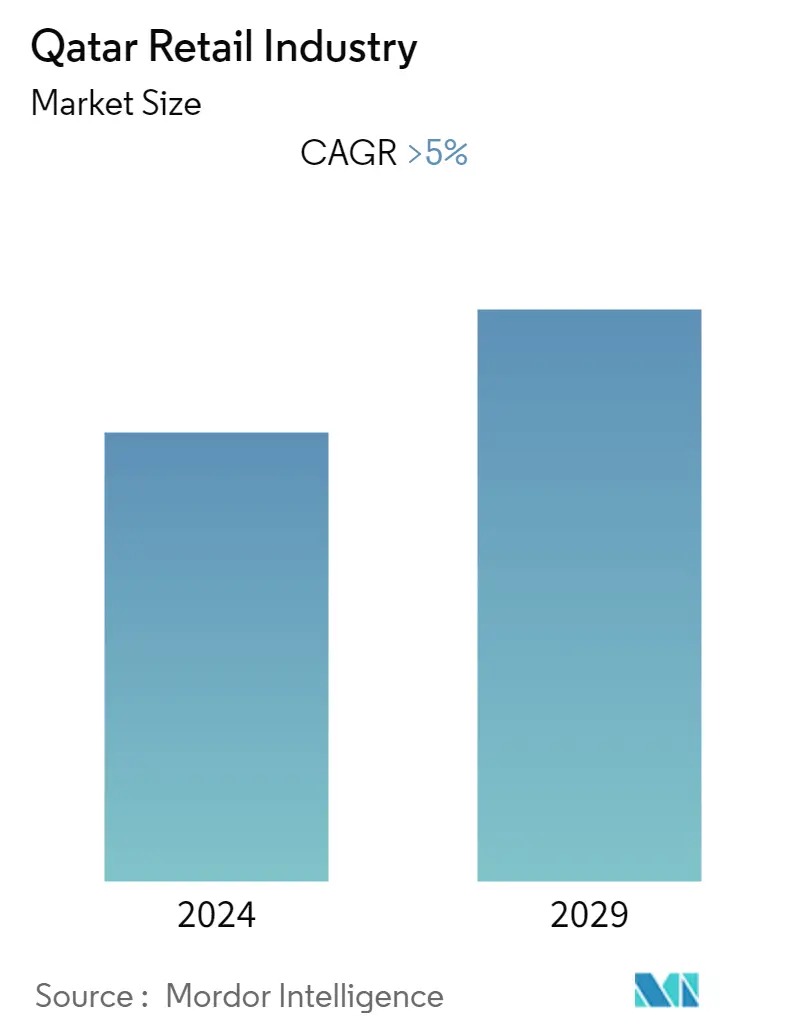
| Study Period | 2019 - 2029 |
| Base Year For Estimation | 2023 |
| Forecast Data Period | 2024 - 2029 |
| Historical Data Period | 2019 - 2022 |
| CAGR | 5.00 % |
| Market Concentration | Medium |
Major Players_-_Copy.webp)
*Disclaimer: Major Players sorted in no particular order |
Qatar Retail Market Analysis
The Qatar retail industry is expected to grow at a CAGR of greater than 5% in the forecasted period. The e-commerce industry includes the digital channel-based sale of tangible commodities to individual end-users. This definition includes purchases made using mobile devices and desktop computers (including notebooks and laptops). Digitally distributed services, media downloads or streaming, items delivered digitally in B2B markets, and the digital purchase or resale of worn, damaged, or repaired goods are not included in the e-commerce market. All monetary amounts are expressed in the annual gross revenue, excluding shipping expenses.
The COVID-19 pandemic significantly affected the retail sector in Qatar, as overall consumer spending decreased. However, the e-commerce sector saw an incremental rise during the lockdowns and restrictions on movement imposed by the local governments.
Despite the worldwide slump, Qatar's retail sector performed well. Although stores had to close in the spring due to lockdown measures by governments worldwide to stop the spread of COVID-19, reopening started as early as that summer. Since then, several health regulations have been implemented at malls and retail establishments in Qatar to welcome customers. Even though median monthly rents decreased, a few new malls opened in the base year, and more are anticipated for the following year, thanks to pent-up demand for goods and socializing. Online delivery and minimal supply disruption during the pandemic helped grocery stores, mainly thanks to Qatar's pre-pandemic drive to increase food security and diversify trading.
Qatar Retail Industry Segmentation
In contrast to wholesale, which involves selling to businesses or institutions, retail involves selling goods and services to people.
The Qatar Retail Industry is Segmented by Products (Food and Beverages, Personal and Household Care, Apparel, Footwear and Accessories, Furniture, Toys and Hobbies, Electronic and Household Appliances, and Other Products), By Distribution Channels (Supermarkets/Hypermarkets, Convenience Stores, and Department Stores, Specialty Stores, Online, and Other Distribution Channels). The report offers Market size and forecasts for the Retail Industry in Qatar Market in value (USD Million) for all the above segments.
| Food and Beverages |
| Personal and Household Care |
| Apparel, Footwear, and Accessories |
| Furniture, Toys, and Hobby |
| Electronic and Household Appliances |
| Other Products |
| Supermarkets/Hypermarkets, Convenience Stores, and Department Stores |
| Speciality Stores |
| Online |
| Other Distribution Channels |
Qatar Retail Industry Size Summary
The Qatar retail market is poised for significant growth, driven by a robust economic environment and a high standard of living. The sector is experiencing a transformation, with a notable shift towards organized retail spaces and e-commerce platforms. The COVID-19 pandemic acted as a catalyst for this digital shift, as retailers rapidly adapted to the challenges posed by lockdowns and movement restrictions. The introduction of digital payment systems and the expansion of online shopping capabilities have been pivotal in maintaining consumer engagement and facilitating market expansion. Despite the pandemic's initial impact, the retail sector in Qatar has shown resilience, with new shopping malls and retail spaces opening to meet the pent-up demand for goods and social interactions.
Qatar's retail industry benefits from a wealthy consumer base and a high urbanization rate, making it an attractive market for both local and international retailers. The market is characterized by a competitive landscape, with major players like Chalhoub Group, Alshaya, and Al Tayer Group dominating the scene. These companies are actively expanding their presence and exploring new commercial opportunities, particularly in the organized retail segment. The ongoing development of large-scale retail spaces, such as Place Vendome, underscores the country's commitment to enhancing its retail infrastructure. Collaborations and strategic partnerships, such as those between AZADEA Group and BOSE, further illustrate the dynamic nature of the market, as retailers seek to innovate and improve the consumer shopping experience.
Qatar Retail Industry Size - Table of Contents
1. MARKET DYNAMICS AND INSIGHTS
- 1.1 Market Overview
-
1.2 Market Drivers
- 1.2.1 Demographics and Consumer Behavior
- 1.2.2 Infrastructure Development
-
1.3 Market Restraints
- 1.3.1 Cultural Sensitivity
-
1.4 Industry Attractiveness - Porters' Five Forces Analysis
- 1.4.1 Threat of New Entrants
- 1.4.2 Bargaining Power of Buyers
- 1.4.3 Bargaining Power of Suppliers
- 1.4.4 Threat of Substitutes
- 1.4.5 Intensity of Competitive Rivalry
- 1.5 Insights on Impact of Technology and Innovation in Operation in Retail Industry Market
- 1.6 Impact of COVID-19 on the Market
2. MARKET SEGMENTATION
-
2.1 By Product
- 2.1.1 Food and Beverages
- 2.1.2 Personal and Household Care
- 2.1.3 Apparel, Footwear, and Accessories
- 2.1.4 Furniture, Toys, and Hobby
- 2.1.5 Electronic and Household Appliances
- 2.1.6 Other Products
-
2.2 By Distribution Channel
- 2.2.1 Supermarkets/Hypermarkets, Convenience Stores, and Department Stores
- 2.2.2 Speciality Stores
- 2.2.3 Online
- 2.2.4 Other Distribution Channels
Qatar Retail Industry Market Research Faqs
How big is the Qatar Retail Industry?
The Qatar Retail Industry size is expected to reach USD 25.37 billion in 2025 and grow at a CAGR of 4.80% to reach USD 32.07 billion by 2030.
What is the current Qatar Retail Industry size?
In 2025, the Qatar Retail Industry size is expected to reach USD 25.37 billion.


